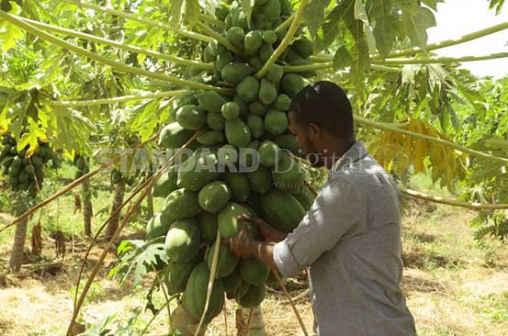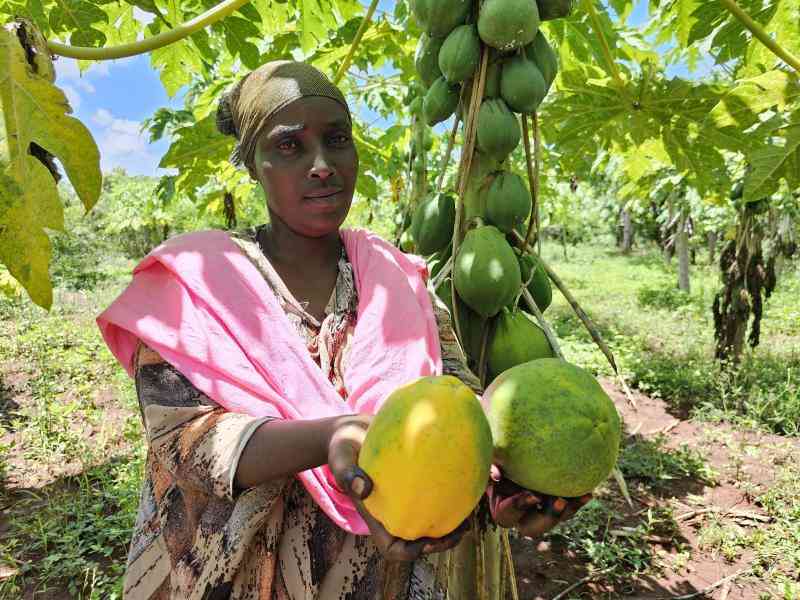
Papayas (paw paws) are like a gift from the gods! Easy to grow in home gardens and have a delicious, sweet flesh that can be enjoyed at the breakfast table for most of the year. Pawpaw performs well in most parts of the country. If you grow your own papayas, then it means that you’ll never be without these wonderfully tropical fruits due to their long harvest period.
What’s the secret to growing?
Growing papaya from seed is the easiest and most successful way to get started. And of course it’s also the cheapest. Just cut the papaya in half, scrape out the seeds and dry them and you will end up with enough seeds to grow a papaya plantation. For a successful crop, ensure you have a bisexual tree or otherwise you’ll need to grow both male and female trees (see story below).
It’s impossible to tell the sex of a plant until the tree starts to flower, so plant multiple seeds. When flowering commences, identify and cut the male trees off at ground level, leaving one female tree.
To grow good papayas you need a frost free climate, lots of sunlight, water and good soils rich in organic matter with good drainage. Papayas don’t transplant well. Anything that disturbs the roots of papayas sets them back. The most fool proof way to grow papayas is to simply plant them where they are to live.
Papaya trees are very hungry because they are prolific fruiters in? warm climates and so require a lot of fertilising. They are particularly avaricious for nitrogen. Fertilise them regularly.
You can use a complete fertiliser, or something like chicken manure. Papayas handle strong or fresh manures fairly well. You should also be generous with compost, and just keep piling on the mulch as the plants grow bigger. When planting, allow enough space between the trees to encourage air flow which will reduce mildew attack and allow pollinating insects to roam freely around them. Mulch well after planting and water well. The seeds should take about a couple of weeks to germinate you will notice that your seedlings will be of different sizes and vigour. Start culling the weaker ones. Only keep the very best!
The male papayas don’t bear fruit. Papayas start flowering when they are about one metre tall. The males flower first.
Male flowers have long, thin stalks with several small blooms. Female flowers are usually single blooms, bigger, and very close to the trunk. Cull most of the male plants. You only need one male for every ten to female plants to ensure good pollination. If the weather is warm enough, and if you are growing your papayas in full sun and in good soil, then you could be picking the first ripe fruit within 10 months.
Papayas fruit all year round, as long as the weather is warm enough. Keep them happy and they will keep fruiting. Young papayas are the most productive. The older a papaya plant gets, the weaker it becomes. It will produce less and smaller fruit, and it may be susceptible to diseases. Also, because the plants keep growing taller it gets harder to reach the fruit. I suggest you just keep planting more. Put in another patch every few months. That way, you always have some healthy and productive plants around, and you don’t need a ladder to pick the fruit.
Supply enough water. Papayas have large soft leaves. They evaporate a lot of water in warm weather, so they need a lot of water. But unfortunately papayas are susceptible to root rot, especially in cool weather. Overwatering is the most common reason for problems when growing papayas.
Varieties
There are different varieties of papaya found in Kenya. The major ones are, the solo variety which is a Hawaiian variety that produces small round sweet fruits with uniform size and shape. It is hermaphroditic and popular for both export and local markets. The mountain variety grows at high altitudes with small fruits only suitable for jam and preserves. The sunrise is also a Hawaiian variety that produces smooth pear shaped fruit of high quality, weighing 400 to 650 grams. The flesh is reddish orange. This variety is also high yielding. There are also some improved breeds such as the red royale that give good quality yields produced by Jomo Kenyatta University of Agriculture and Technology. Vegetative propagation of papaya using tissue culture can result in superior plants that are disease resistant, produce high yields and are easy to maintain and harvest because the trees are short.
Common problems
Stay informed. Subscribe to our newsletter
Papaya crinkle virus seen as wrinkled mature leaves will kill the plant. If this is evident, either remove the plant completely or try a rescue remedy by cutting back the tree to half its size and fertilising well. For black spots that appear on the fruit in humid and wet weather, spray with an organic copper-based fungicide spray.
Root rot is the most common due to overwatering. If you get cool weather keep you papaya plants dry. Strong winds are another common cause of papaya disaster. Papaya plants have a shallow root system, they get very top heavy as they grow older, and they blow over easily.
Then there are birds and fruit bats. The only solution here is to pick the fruit as soon as it starts to change colour. Control broad mites with ?a sulphur spray. Keep an eye out for aphids and? caterpillars, which can ?be hosed off and squashed if the infestation isn’t too severe. Get rid of fruit fly by hanging fruit fly Traps around the trees. To reduce fruit rot and fungal problems, pick the fruit early and ripen it indoors. In humid weather watch for mildew, which can be controlled with good airflow around the plants and can be controlled with fungicides
Harvesting Paw paws fruit 9-18 months after planting so give suitable climate. A good strategy is to harvest the fruit just before it ripens so pick it when it’s about two-thirds golden in colour and allow it to finish ripening indoors. In the good climate, fruits will grow all year round and healthy trees can produce up to 30kg of fruit each growing season.
Determining sex of a papaya tree
Until the seedlings start to bloom months after germination I know of no way to tell them apart. The following excerpt from a Florida Extension Service Publication give some information on male, female and hermaphroditic (bisexual) papaya plants, and guidelines for selecting seeds to insure better percentages of female and hermaphroditic plants.
The papaya is a polygamous species. The plants may be classified into three primary sex types: the male (staminate), hermaphroditic (bisexual), and female (pistillate). In addition, some plants can produce, at the same time, more than one kind of flower. Also, some produce flowers which are not of these basic forms, but exhibit different degrees of maleness and femaleness. This tendency to change in sexual expression seems to be triggered by climatic factors, such as drought and variable temperatures. The tendency to produce male flowers seems to increase at high temperatures. Since male trees are unfruitful and fruit from bisexual plants is preferred in some markets, it is important to select seed which will give a maximum number of fruitful trees of the desired type. This cannot be done by simply saving seed from productive open-pollinated plants, but one can predict fairly accurately the progeny by knowing the source of pollen and the kind of flower the fruit came from. Accordingly, the grower must hand pollinate to obtain the desired combination of flower types.
This is done by covering an unopened flower, either bisexual or pistillate, with a paper bag until it opens and then transferring the desired pollen onto the receptive pistil. Pollination studies have shown that: 1)pistillate (female) flowers pollinated by staminate (male) flowers give equal numbers of male and female progeny; 2) pistillate flowers pollinated by pollen from bisexual flowers give an equal number of female and bisexual progeny, 3)bisexual flowers either self-pollinated or crossed-pollinated with other bisexuals give a ratio of one female to 2 bisexual, 4) bisexual flowers pollinated by staminate ones produce equal numbers of female, male and bisexual progeny. It is evident that the second and third combinations will produce the maximum number of fruit-bearing plants.
-The writer is an expert/consultant on agricultural solutions and innovations
 The Standard Group Plc is a
multi-media organization with investments in media platforms spanning newspaper
print operations, television, radio broadcasting, digital and online services. The
Standard Group is recognized as a leading multi-media house in Kenya with a key
influence in matters of national and international interest.
The Standard Group Plc is a
multi-media organization with investments in media platforms spanning newspaper
print operations, television, radio broadcasting, digital and online services. The
Standard Group is recognized as a leading multi-media house in Kenya with a key
influence in matters of national and international interest.
 The Standard Group Plc is a
multi-media organization with investments in media platforms spanning newspaper
print operations, television, radio broadcasting, digital and online services. The
Standard Group is recognized as a leading multi-media house in Kenya with a key
influence in matters of national and international interest.
The Standard Group Plc is a
multi-media organization with investments in media platforms spanning newspaper
print operations, television, radio broadcasting, digital and online services. The
Standard Group is recognized as a leading multi-media house in Kenya with a key
influence in matters of national and international interest.







